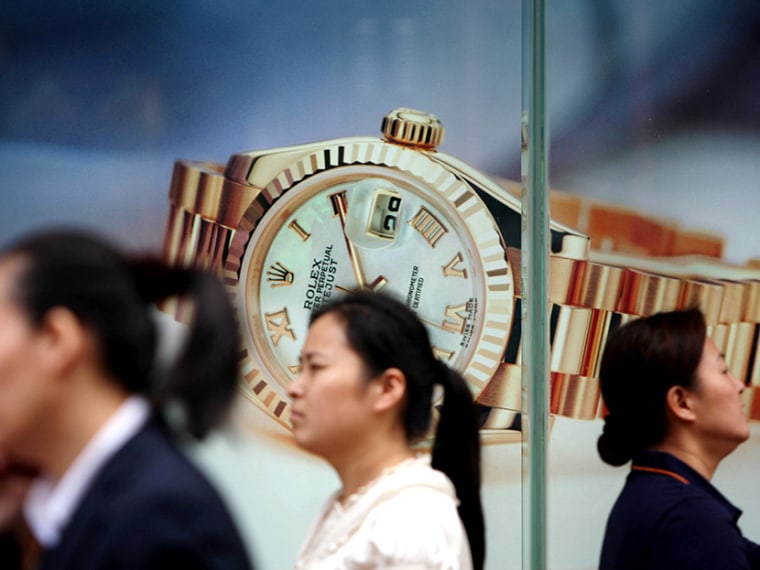In the exquisite French film The Earrings of Madame De … (1953), the passage of a single pair of expensive diamond earrings through a succession of aristocratic hands is made to represent human folly, vanity, infidelity, and hypocrisy. If Hollywood were to remake the film, substituting corrupt American politicians for corrupt French nobles, the item of jewelry would have to be a Rolex watch.
“Good rule for politicians who want to stay out of jail,” tweets Emily Yoffe, who writes the “Dear Prudence” advice column in Slate. “Timex, not Rolex.” Virginia Gov. Bob McDonnell faces possible indictment over, among other things, the gift of a Rolex watch valued at $6,500. Former Rep. Jesse Jackson, Jr., will spend 30 months in prison for spending campaign funds on, among other things, a Rolex watch valued at $43,000. Former Birmingham, Ala., Mayor Larry Langford is currently serving a 15-year prison sentence on bribery charges that included accepting a Rolex watch that he later sold for $8500.
For any politician who didn’t enter office a wealthy man, nothing says “I take bribes” like a Rolex watch. (Female politicians sometimes take bribes too, of course, but their taste in jewelry, being more subtle and diverse, doesn’t lend itself to caricature.)
To be sure, plenty of Rolex-wearers are law-abiding citizens. The political columnist Mark Shields recently pointed out (while similarly marveling at the crooked male politician’s affinity for the Rolex) that the Dalai Lama is a Rolex man. But while most Rolex-wearers may not be white-collar criminals, it seems like most white-collar criminals are Rolex-wearers.
It isn’t just politicians. Scott London, an accountant at KPMG who last May plead guilty to securities fraud, swapped insider tips in exchange for bribes from a jeweler that included a $12,000 Rolex. Ponzi King Bernie Madoff had 17 Rolexes, including an Oyster chronograph whose cost exceeds one year’s tuition and fees at Harvard College.
For politicians, the brazen acceptance of opulent gifts from favor-seekers is a very old story. Suddenly you find yourself hobnobbing with very wealthy people. You can’t keep up, and they all want to help out. It means so little to them and so much to you, and especially your family, who endured untold sacrifices while you sought the big brass ring of public office.
But the Rolex shows that bribe-taking isn’t really about securing life’s necessities. Nobody needs a Rolex. For any practical use, a $15 wristwatch from CVS will serve just as well.
Rolex-wearing is what the economist Thorstein Veblen referred to as “conspicuous waste,” i.e., a visual demonstration that “the wearer consumes valuable goods in excess of what is required." Such wearable status symbols are intended (Veblen wrote) to convey that “the wearer is not engaged in any kind of productive labor,” by which Veblen really meant manual labor, because—let’s get real—you can’t dig a ditch while wearing a Rolex. In effect, the wearer is saying: I couldn’t be a peasant if I tried.
Just as the Rolex conveys power and success, its absence conveys weakness and failure. Four years ago a rich friend of Nicolas Sarkozy, then president of France, was asked about Sarkozy’s Rolex, which reportedly was worth about $16,000. “Everyone has a Rolex,” the rich friend replied. “If you don’t have a Rolex by the time you reach 50, then you have clearly failed in your life.” Even in luxury-besotted France, this was widely judged an appalling remark. But it probably describes accurately what a certain class of power-seeking males around the globe actually feels.
For politicians, lust for expensive watches is what psychologists call “maladaptive.” That’s because the public takes a very dim view of conspicuous waste and apparent contempt for proletarian toil. Working people vote! In 1982 Mario Cuomo used this insight to beat out Lewis Lehrman, a wealthy former president of Rite Aid, and become governor of New York. Lehrman’s fate was sealed during a debate when Cuomo suddenly looked at Lehrman’s wrist. “That’s a very expensive watch, Lou,” Cuomo said. The poor plutocrat never knew what hit him. History does not relate whether the watch was a Rolex, but it might as well have been.
There is one group in America that almost certainly loves Rolexes even more than status-anxious politicians and tycoons. That would be prosecutors. If their legal pursuit of Langford, Jackson, and now McDonnell is any indication, no more reliable “tell” exists that a politician is on the take than the presence on his wrist of a Rolex. Wear it and you’d better be able to demonstrate that you either earned or inherited millions before you ever thought of entering public life. If you can’t, then all you’ll likely get from that glittering, manly totem is a trip to the slammer.
